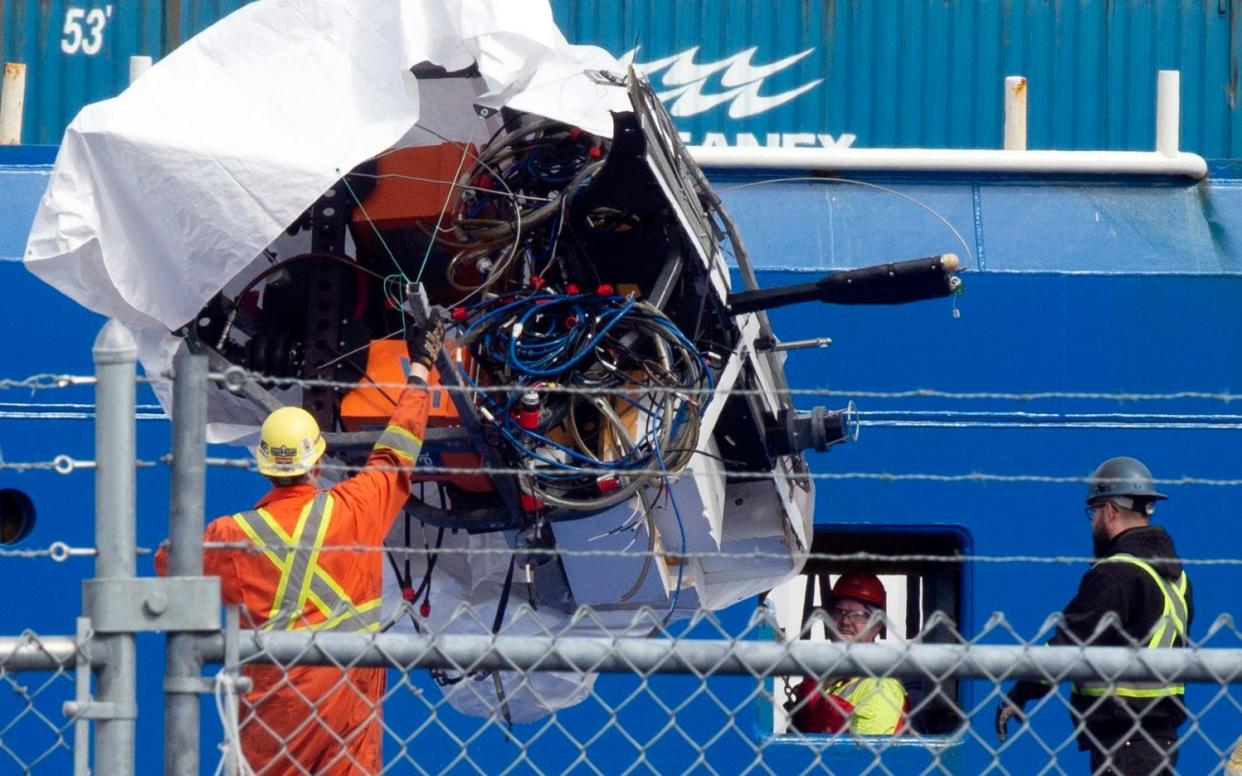‘Presumed human remains’ recovered from wreckage of Titan sub

Presumed human remains have been recovered from the wreckage of the Titan submersible, the US Coast Guard has confirmed.
Medical professionals will formally analyse the remains which are understood to have been found within the debris from the sea floor at the site of the deep-sea vessel’s fatal implosion, which killed five people.
British adventurer Hamish Harding and father and son Shahzada and Suleman Dawood were killed on board the vessel near the wreckage of the Titanic, alongside OceanGate Expeditions’ chief executive, Stockton Rush, and French national Paul-Henri Nargeolet.
Large pieces of debris from Titan were transported to St John’s harbour on Wednesday by the Horizon Arctic ship, where it was seen being unloaded by a crane.
An underwater robot carried to the site by the Horizon Arctic had dived to the ocean floor to search for the Titan during the multi-day, international search.
The recovered debris was covered in large tarpaulin as it reached land on Wednesday.
The pieces were lifted by cranes onto lorries and taken away to be assessed. However, some of the pieces appeared to show the outer casing of the 21ft vessel.
All five passengers on board the Titan were killed on the expedition to the wreck of the Titanic, which lies around two miles below sea level around 400 miles from the coast of Newfoundland.
The return of the debris to port in St John’s, Newfoundland, is a key piece of the investigation into why the submersible imploded, killing all five people on board.
Twisted chunks of the 22ft submersible came ashore at a Canadian Coast Guard pier on Wednesday.
Horizon Arctic, a Canadian ship, carried a remotely operated vehicle, or ROV, to search the ocean floor near the Titanic wreck for pieces of the submersible.
Pelagic Research Services, a company with offices in Massachusetts and New York that owns the ROV, said in a statement on Wednesday that it has completed offshore operations.
Pelagic Research Services said its team is “still on mission” and cannot comment on the ongoing Titan investigation, which involves several government agencies in the US and Canada.
“They have been working around the clock now for 10 days, through the physical and mental challenges of this operation, and are anxious to finish the mission and return to their loved ones,” said the company’s statement.

Debris from the Titan was located about 12,500ft (3,810 metres) underwater and roughly 1,600ft (488 metres) from the Titanic on the ocean floor, the Coast Guard said last week.
The Coast Guard is leading the investigation into why the submersible imploded during its June 18 descent. Officials announced on June 22 that the submersible had imploded and all five people on board had died.
Speaking after the evidence was recovered, the Marine Board of Investigation’s chairman, Captain Jason Neubauer, said: “The evidence will provide investigators from several international jurisdictions with critical insights into the cause of this tragedy.
“There is still a substantial amount of work to be done to understand the factors that led to the catastrophic loss of the Titan and help ensure a similar tragedy does not occur again.”
One of the experts the Coast Guard consulted with during the search said analysing the recovered debris could reveal important clues about what happened to the Titan.
And there could be electronic data, said Carl Hartsfield, of the Woods Hole Oceanographic Institution.
“Certainly all the instruments on any deep sea vehicle, they record data. They pass up data. So the question is, is there any data available? And I really don’t know the answer to that question,” he said Monday.
The National Transportation Safety Board has said the Coast Guard has declared the loss of the Titan submersible to be a “major marine casualty”. The Coast Guard will lead the investigation.
Coast Guard representatives declined to comment on the investigation or the return of debris to shore on Wednesday. Representatives for the National Transportation Safety Board and Transportation Safety Board of Canada, which are both involved in the investigation, also declined to comment.
“We are not able to provide any additional information at this time as the investigation is ongoing,” said Liam MacDonald, a spokesman for the Transportation Safety Board of Canada.

OceanGate Expeditions, the company that owned and operated the Titan, is based in the US, but the submersible was registered in the Bahamas.
OceanGate is based in Everett, Washington, but closed when the Titan was found.
Meanwhile, the Titan’s mother ship, the Polar Prince, was from Canada. Those killed were from England, Pakistan, France, and the US.
Killed in the implosion were Stockton Rush, chief executive of OceanGate and the pilot; Shahzada Dawood and his son Suleman Dawood, two members of a prominent Pakistani family; Hamish Harding, a British adventurer; and Paul-Henri Nargeolet, a Titanic expert.
The operator charged passengers $250,000 (£196,375) each to participate in the voyage.
The implosion of the Titan has raised questions about the safety of private undersea exploration operations. The Coast Guard also wants to use the investigation to improve the safety of submersibles.

